Home / HOMO and LUMO In the Diels Alder Reaction
Dienes and MO Theory
HOMO and LUMO In the Diels Alder Reaction
Last updated: February 7th, 2023 |
The HOMO and LUMO In The Diels Alder Reaction
- The Diels-Alder reaction is a concerted reaction between a diene (with 4 pi-electrons) and a dienophile (2 pi-electrons) that forms a new 6-membered ring
- The new C-C sigma bonds are formed from the overlap of the pi molecular orbitals at C1 and C4 of the diene and C1 and C2 of the dienophile.
- In order for the new bonds to form, there has to be constructive overlap between these orbitals – that is, they have to have the same phase.
- By analyzing the molecular orbitals of the diene and dienophile in the Diels-Alder reaction, it becomes clear that constructive overlap is possible between the highest-occupied molecular orbital (HOMO) of the diene with the lowest-unoccupied molecular orbital (LUMO) of the dienophile.
- This type of overlap is not possible in a reaction between two alkenes.
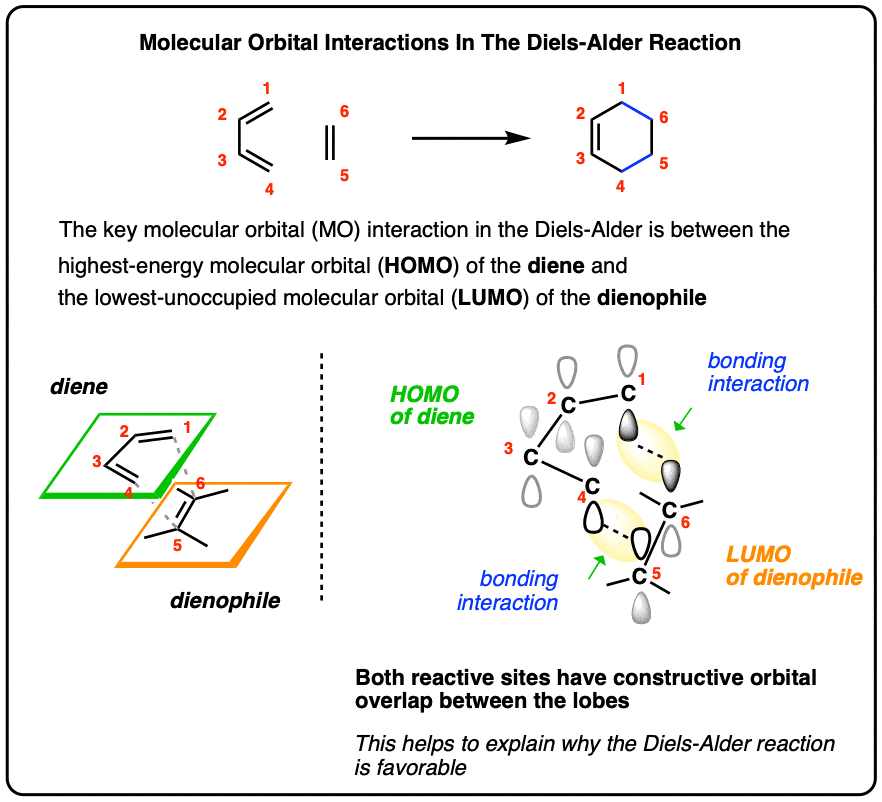
Table of Contents
- A Quick Recap Of The Diels-Alder Reaction
- Bond Formation Requires Overlap Between The HOMO Of One Molecule (The Nucleophile) With The LUMO Of Another Molecule (The Electrophile)
- Concerted Reactions: When Two Bonds Form At The Same Time, Multiple Orbitals Must Overlap
- Molecular Orbitals In The [2+2] Cycloaddition Between Ethene And Ethene Show Why The Reaction Is Unfavorable Under “Thermal” Conditions
- Molecular Orbitals In The Diels-Alder Reaction: Interaction of the Diene HOMO with the Dienophile LUMO Is Favorable At Both Bond-Forming Sites
- Under “Photochemical” Conditions, The [2+2] Actually Works Pretty Well
- Summary – The Key Role Of Orbital Symmetry In Concerted Reactions Of Pi-Systems
- Notes
1. A Quick Recap Of The Diels-Alder Reaction
Today we’re going to go into the mechanism of the Diels-Alder reaction from a molecular orbital perspective. Using our previous posts on how to build up molecular orbitals, we’ll show how the Diels-Alder results from the constructive orbital overlap between the highest-occupied molecular orbital (HOMO) of the diene with the lowest-unoccupied molecular orbital (LUMO) of the dienophile.
But first, let’s recap where we are with the Diels-Alder so far:
- The Diels-Alder reaction combines a diene with a dienophile to form a new six-membered ring [see: Introduction to the Diels-Alder reaction]
- three bonds form (two sigma bonds and a pi bond) and three bonds break (three pi bonds)
- the stereochemistry of the product can be reliably predicted from analyzing the stereochemistry of the diene and dienophile [see: Stereochemistry of the Diels-Alder Reaction]
- in certain cases, mixtures of diastereomers (exo– and endo- ) are obtained. Generally the endo– is favored over the exo. [see this post on exo and endo]
What we haven’t really covered is why the Diels-Alder actually works. After all, we’ve seen plenty of examples of things that don’t work; two alkenes, for example, don’t combine to form four membered rings upon heating in the way that a diene and a dienophile combine to form a six-membered ring. Nor do two dienes combine easily upon heating to give eight-membered rings.
Why is the Diels-Alder so easy, and many seemingly related reactions so hard?
The answer to this question lies in the arrangement of pi molecular orbitals in the two components of this reaction.
In the 1960’s a theory of orbital symmetry was developed to understand these reactions, which provided a very useful set of predictive rules – the Woodward-Hoffmann rules.
We will scratch the surface of the orbital symmetry rules here and use them to show why the reaction of dienes with alkenes (the Diels-Alder) occurs readily upon heating, but the reaction of alkenes with alkenes (a.k.a. [2+2] cycloadditions) does not.
2. Bond Formation Requires Overlap Between The HOMO Of One Molecule (The Nucleophile) With The LUMO Of Another Molecule (The Electrophile)
Most reactions we’ve seen involve a nucleophile (an electron-pair donor) reacting with an electrophile (an electron-pair acceptor) to form ONE new bond.
In order for that bond to form, the filled orbital on the nucleophile containing the electron pair has to come into contact (overlap) with the empty orbital on the electrophile which can accept the electron pair.

[Perfect orbital overlap between nucleophile and electrophile.]
- The pair of electrons on the nucleophile almost always comes from the highest-energy occupied molecular orbital (HOMO) of the nucleophile. Why? Because these are the electrons that are the least tightly held.
- The orbital on the electrophile that accepts the pair of electrons is almost always the lowest-energy unoccupied molecular orbital (LUMO), because this will result in the lowest-energy transition state (and the fastest reaction).
In most reactions (such as the SN2) only one bond is forming at a given center at any one time:
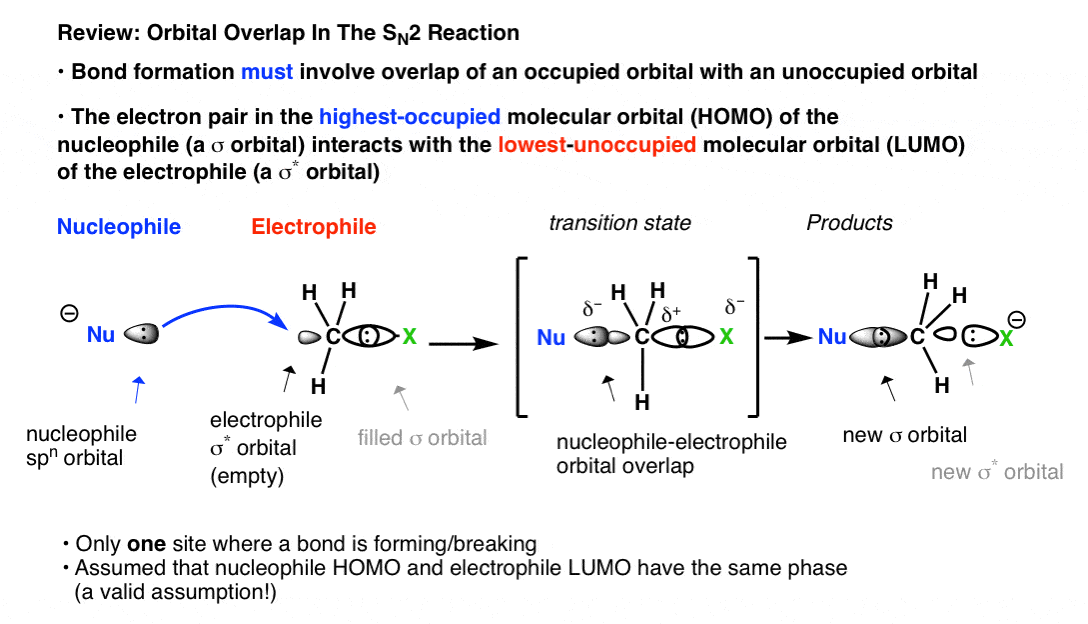
One little note. In the SN2 we make the assumption that the HOMO and LUMO have the same phase. This is perfectly valid – so long as we’re only dealing with one bond being formed at a time.
3. Concerted Reactions: When Two Bonds Form At The Same Time, Multiple Orbitals Must Overlap
Things get more complex when we have a reaction where two or more bonds are formed at the exact same time. This is known as a concerted reaction (as opposed to “stepwise”).
Take the combination of two alkenes to give a cyclobutane ring. (This is often called a [2+2] cycloaddition.)
Since we have two bonds forming at the same time, we have two orbital interactions to consider.
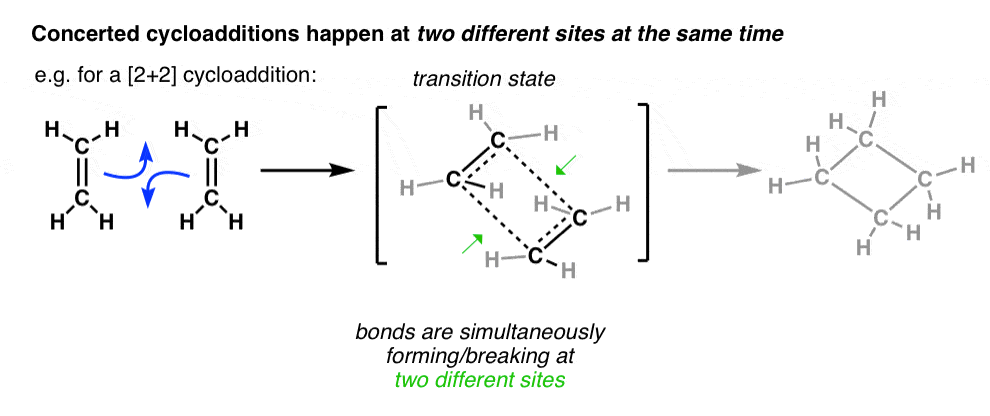
What’s the nucleophile and the electrophile here?
Ethene and ethene. : – )
More specifically, the nucleophile is the HOMO of one ethene molecule, and the electrophile is the LUMO of another ethene.
The HOMO of one ethene molecule must combine with the LUMO of another ethene molecule. [We can’t combine two occupied orbitals – Nature has a strict 2-electron occupancy limit per orbital. And since we can’t form a bond without electrons, combining two LUMOs would be silly]
4. Molecular Orbitals In The [2+2] Cycloaddition Between Ethene And Ethene Show Why The Reaction Is Unfavorable Under “Thermal” Conditions
Let’s look at the π molecular orbitals of ethene. The HOMO has zero nodes, and the LUMO has a single node. [We learned how to build up molecular orbitals of ethene in this post].
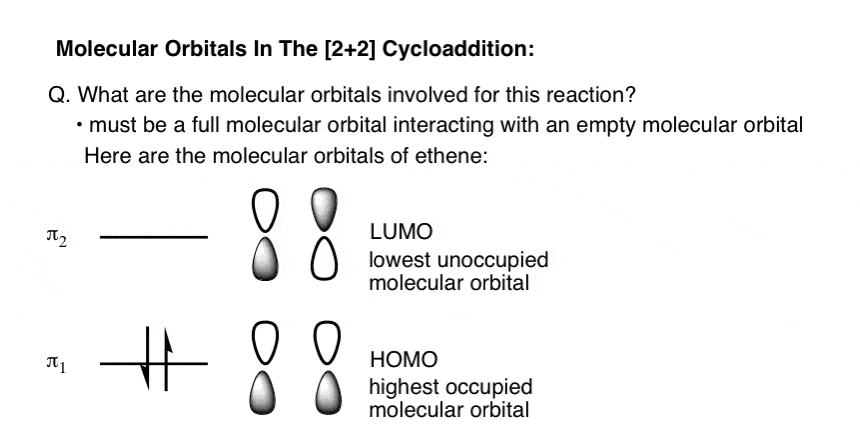
In order for the reaction to occur in a concerted fashion, we must have constructive overlap between each of the lobes where the bonds are being formed. [If the phases are opposite, there is destructive interference between the orbitals and therefore zero electron density between the atoms]
Now let’s bring the two molecules of ethene together:
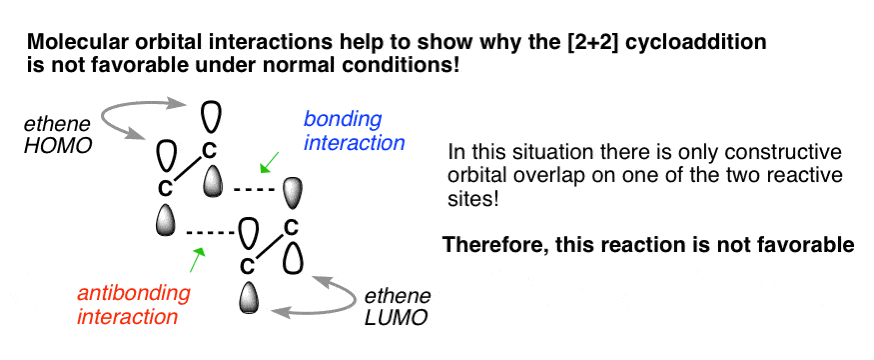
Note that only one of the interactions between the lobes has lobes of like phase interacting (bonding). The other interaction has lobes of opposite phase interacting, which will not result in a bond. [Note 1]
This helps us understand why [2+2] cycloadditions don’t generally occur under “thermal” conditions (i.e. heating). The orbitals don’t both overlap! [Note 2]
[2+2] cycloadditions do occur under photochemical conditions, however. More on that in a moment.
5. Molecular Orbitals In The Diels-Alder Reaction: Interaction of the Diene HOMO with the Dienophile LUMO Is Favorable At Both Bond-Forming Sites
Now let’s perform the same kind of analysis on the Diels-Alder reaction.
Since we’ve already seen the molecular orbitals of ethene, let’s look at butadiene. [Relevant post: The Pi Molecular Orbitals of Butadiene].
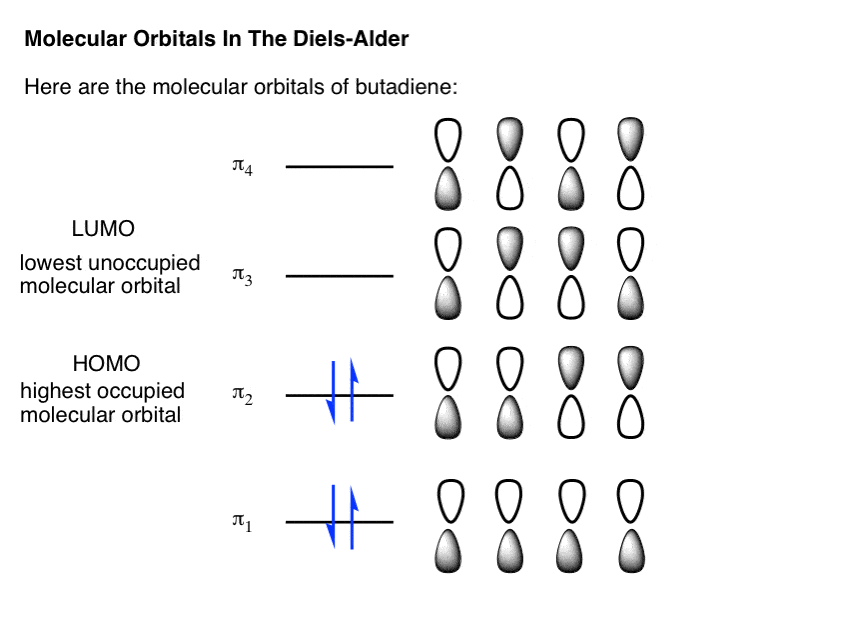
Now let’s see what happens when we try to line up the HOMO of butadiene with the LUMO of ethene.
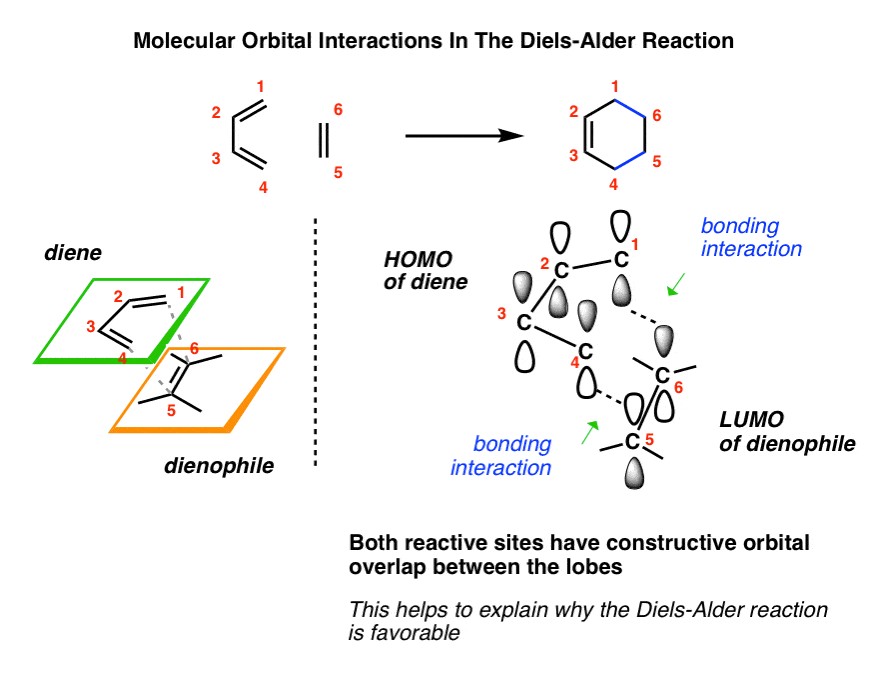
[Why not the other way around, with the LUMO of butadiene and the HOMO of ethene? See Note 3 ]
Here we have the diene (in the green plane) approaching the dienophile (orange plane) from the top, as a helicopter might approach a landing pad. New bonds form between C1 –C6 and C4–C5 . Note that the phases of the lobes for each pair of interactions match and thus have constructive orbital overlap.
[Also note that although the diene is depicted as being on “top” here, it works equally well if it’s on the bottom hover here for a pop-up image or click this link. The symmetry works out in both cases – just like it does for two Lego blocks, even though the phases of the “lobes” on each face are opposite ]
This helps us understand why the Diels-Alder reaction works – the orbital interactions are favorable.
We’ll stop with the Diels-Alder, but [Note 4] continues the discussion [nerds only].
6. Under “Photochemical” Conditions, The [2+2] Actually Works Pretty Well
Above, I said the [2+2] cycloaddition doesn’t work under “normal” conditions, by which I meant “heating”. [Organic chemists usually use the term “thermal” conditions]
However, it’s been observed that if one exposes the reaction to ultraviolet (UV) light, the reaction can proceed quite well. [These are called, “photochemical conditions”].

Why?
Ultraviolet light promotes an electron from the HOMO to the LUMO, resulting in a “new” HOMO. [sometimes called HOMO-prime, or SOMO (for “singly occupied molecular orbital”)]. [Here is a previous post on UV spectroscopy].
Now there are two bonding interactions between the lobes. And the reaction actually works!
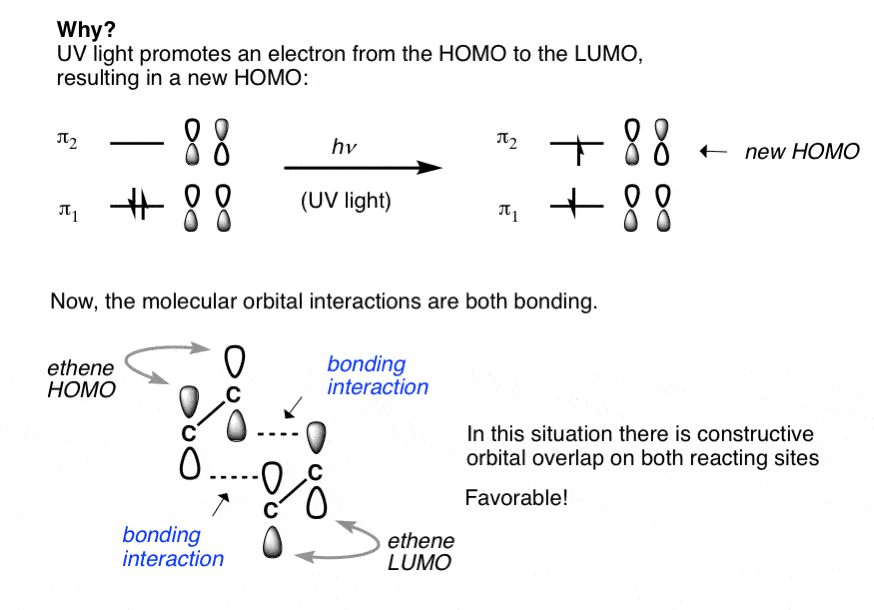
Not that one would want to mess with perfection, but it’s at least worth a brief note that promotion of the Diels-Alder reaction is done through heating, not via photochemical means. An attempt to run a Diels-Alder under “photochemical conditions” would be met with the same failure as a [2+2] cycloaddition under thermal conditions, and for the same reasons – because the orbital symmetry is wrong.
7. Summary – The Key Role Of Orbital Symmetry In Concerted Reactions Of Pi-Systems
Under “thermal conditions” (heating, no UV light) the [2+2] is “forbidden” and the Diels-Alder is “allowed”. [Note 4]
The situation reverses in the presence of ultraviolet light, where an electron can be promoted to give a new HOMO with different orbital symmetry.
Under photochemical conditions, the [2+2] cycloaddition between two alkenes is “allowed” and the Diels-Alder is “forbidden”.
We can boil this all down to a simple table:
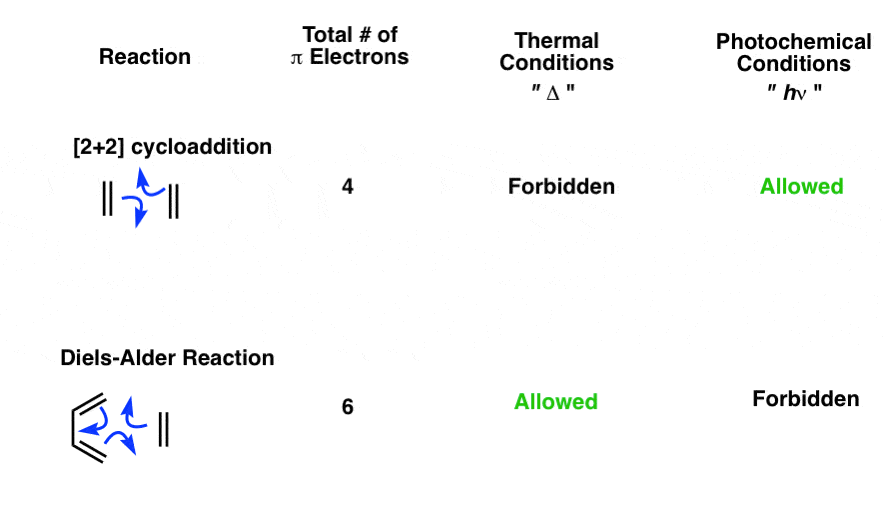
As we continue to explore this topic, we’ll revisit this table and make updates, because there’s a whole family of reactions where orbital symmetry plays a crucial role.
Notes
Related Articles
- Bonding And Antibonding Pi Orbitals
- Molecular Orbitals of The Allyl Cation, Allyl Radical, and Allyl Anion
- Pi Molecular Orbitals of Butadiene
- Exo vs Endo Products In The Diels Alder: How To Tell Them Apart
- Diels-Alder Reaction: Kinetic and Thermodynamic Control
- Regiochemistry In The Diels-Alder Reaction
- The Intramolecular Diels Alder Reaction
Note 1. We’re making the assumption here that one molecule of ethene approaches the other molecule of ethene in the same way we’d bring together two pieces of Lego. The bottom face of one component joins with the top face of another.
Each pair of lobes involved in bonding is on the same face of the molecule. This arrangement is called suprafacial . It’s analogous to “syn“.
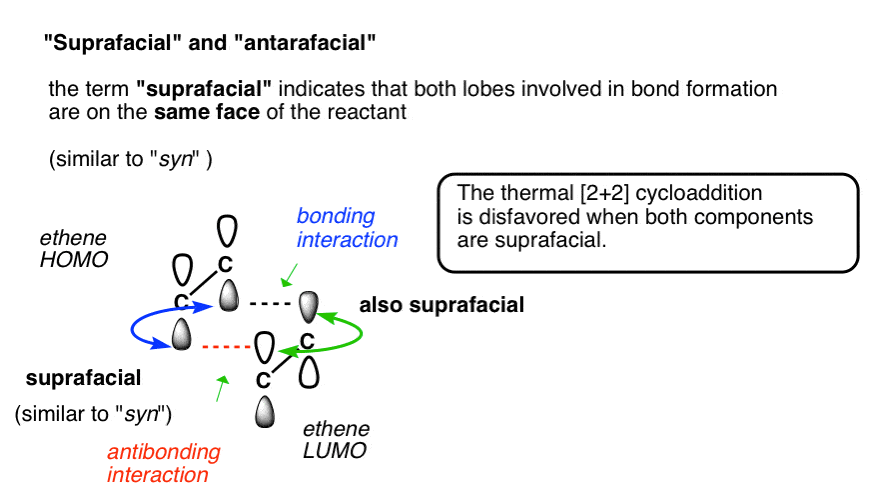
There’s another possibility. What if, instead of the “shaded” lobe of the ethene HOMO combining with the “white” lobe of the LUMO, it instead got together with the “shaded” lobe on the other face of the LUMO. Since both lobes have the same phase, this would be a bonding interaction!
There’s a name for the situation where lobes on opposite faces of a reactant participate in a reaction: it’s called, “antarafacial” (similar to “anti“).
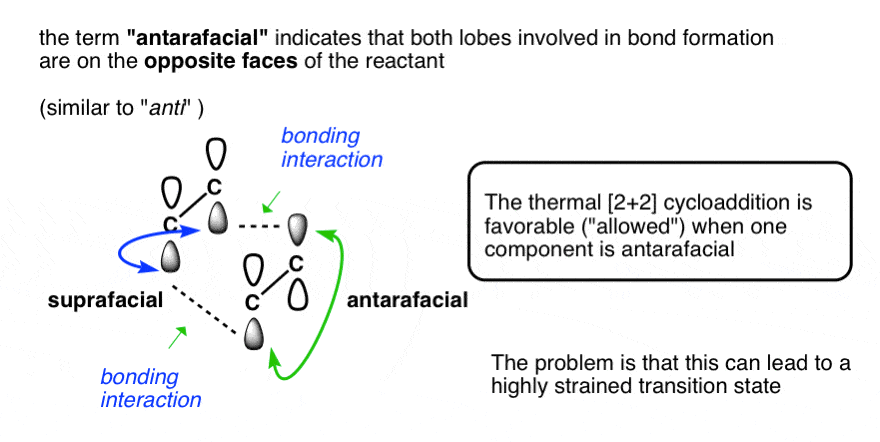
You might ask why this doesn’t happen in the [2+2] cycloaddition between alkenes. If you build a model however, you’ll quickly see that the answer is that it ain’t so frickin’ easy! The transition state for a [2+2] between two alkenes with a single antarafacial component is highly strained.
[There are examples of [2+2] cycloadditions that work under thermal conditions, such as those involving ketenes, that do have an antarafacial component. That’s not a topic for today. ]
Note 2. The success of this analysis implies is that during these types of reactions, the symmetry of the molecular orbitals is conserved – in other words, we can treat the relative phases of the lobes on the orbitals as constant on the timescale of the transition state. This is why these rules are titled, “The Conservation of Orbital Symmetry”.
Note 3. Interactions between the HOMO of the dienophile and the LUMO of the diene are just as favorable from an “orbital symmetry” perspective. The reaction rate, however, will be fastest in situations where the energies of the HOMO/LUMO pair are close together. Most Diels-Alder reactions you’ll see will be of electron-rich dienes (high-energy HOMO) with electron-poor dienophiles (low-energy LUMO).
There are also favorable Diels-Alder reactions between electron-poor dienes (low-energy LUMO) with electron-rich dienophiles (high-energy HOMO). These are known as inverse electron-demand Diels-Alder reactions.
Note 4 – The pattern continues to alternate as additional pi bonds are added; the [4+4] is “thermally forbidden” and the [6+4] is “thermally allowed”. The [6+6] is “thermally forbidden” again, and so on. The cycloaddition with the largest number of pi electrons I am aware of is a [14+2] cycloaddition. This is thermally allowed only because one of the reaction components (heptafulvalene) reacts in an antarafacial fashion.
00 General Chemistry Review
01 Bonding, Structure, and Resonance
- How Do We Know Methane (CH4) Is Tetrahedral?
- Hybrid Orbitals and Hybridization
- How To Determine Hybridization: A Shortcut
- Orbital Hybridization And Bond Strengths
- Sigma bonds come in six varieties: Pi bonds come in one
- A Key Skill: How to Calculate Formal Charge
- The Four Intermolecular Forces and How They Affect Boiling Points
- 3 Trends That Affect Boiling Points
- How To Use Electronegativity To Determine Electron Density (and why NOT to trust formal charge)
- Introduction to Resonance
- How To Use Curved Arrows To Interchange Resonance Forms
- Evaluating Resonance Forms (1) - The Rule of Least Charges
- How To Find The Best Resonance Structure By Applying Electronegativity
- Evaluating Resonance Structures With Negative Charges
- Evaluating Resonance Structures With Positive Charge
- Exploring Resonance: Pi-Donation
- Exploring Resonance: Pi-acceptors
- In Summary: Evaluating Resonance Structures
- Drawing Resonance Structures: 3 Common Mistakes To Avoid
- How to apply electronegativity and resonance to understand reactivity
- Bond Hybridization Practice
- Structure and Bonding Practice Quizzes
- Resonance Structures Practice
02 Acid Base Reactions
- Introduction to Acid-Base Reactions
- Acid Base Reactions In Organic Chemistry
- The Stronger The Acid, The Weaker The Conjugate Base
- Walkthrough of Acid-Base Reactions (3) - Acidity Trends
- Five Key Factors That Influence Acidity
- Acid-Base Reactions: Introducing Ka and pKa
- How to Use a pKa Table
- The pKa Table Is Your Friend
- A Handy Rule of Thumb for Acid-Base Reactions
- Acid Base Reactions Are Fast
- pKa Values Span 60 Orders Of Magnitude
- How Protonation and Deprotonation Affect Reactivity
- Acid Base Practice Problems
03 Alkanes and Nomenclature
- Meet the (Most Important) Functional Groups
- Condensed Formulas: Deciphering What the Brackets Mean
- Hidden Hydrogens, Hidden Lone Pairs, Hidden Counterions
- Don't Be Futyl, Learn The Butyls
- Primary, Secondary, Tertiary, Quaternary In Organic Chemistry
- Branching, and Its Affect On Melting and Boiling Points
- The Many, Many Ways of Drawing Butane
- Wedge And Dash Convention For Tetrahedral Carbon
- Common Mistakes in Organic Chemistry: Pentavalent Carbon
- Table of Functional Group Priorities for Nomenclature
- Summary Sheet - Alkane Nomenclature
- Organic Chemistry IUPAC Nomenclature Demystified With A Simple Puzzle Piece Approach
- Boiling Point Quizzes
- Organic Chemistry Nomenclature Quizzes
04 Conformations and Cycloalkanes
- Staggered vs Eclipsed Conformations of Ethane
- Conformational Isomers of Propane
- Newman Projection of Butane (and Gauche Conformation)
- Introduction to Cycloalkanes
- Geometric Isomers In Small Rings: Cis And Trans Cycloalkanes
- Calculation of Ring Strain In Cycloalkanes
- Cycloalkanes - Ring Strain In Cyclopropane And Cyclobutane
- Cyclohexane Conformations
- Cyclohexane Chair Conformation: An Aerial Tour
- How To Draw The Cyclohexane Chair Conformation
- The Cyclohexane Chair Flip
- The Cyclohexane Chair Flip - Energy Diagram
- Substituted Cyclohexanes - Axial vs Equatorial
- Ranking The Bulkiness Of Substituents On Cyclohexanes: "A-Values"
- Cyclohexane Chair Conformation Stability: Which One Is Lower Energy?
- Fused Rings - Cis-Decalin and Trans-Decalin
- Naming Bicyclic Compounds - Fused, Bridged, and Spiro
- Bredt's Rule (And Summary of Cycloalkanes)
- Newman Projection Practice
- Cycloalkanes Practice Problems
05 A Primer On Organic Reactions
- The Most Important Question To Ask When Learning a New Reaction
- Curved Arrows (for reactions)
- Nucleophiles and Electrophiles
- The Three Classes of Nucleophiles
- Nucleophilicity vs. Basicity
- What Makes A Good Nucleophile?
- What Makes A Good Leaving Group?
- 3 Factors That Stabilize Carbocations
- Equilibrium and Energy Relationships
- 7 Factors that stabilize negative charge in organic chemistry
- 7 Factors That Stabilize Positive Charge in Organic Chemistry
- What's a Transition State?
- Hammond's Postulate
- Learning Organic Chemistry Reactions: A Checklist (PDF)
- Introduction to Oxidative Cleavage Reactions
06 Free Radical Reactions
- Bond Dissociation Energies = Homolytic Cleavage
- Free Radical Reactions
- 3 Factors That Stabilize Free Radicals
- What Factors Destabilize Free Radicals?
- Bond Strengths And Radical Stability
- Free Radical Initiation: Why Is "Light" Or "Heat" Required?
- Initiation, Propagation, Termination
- Monochlorination Products Of Propane, Pentane, And Other Alkanes
- Selectivity In Free Radical Reactions
- Selectivity in Free Radical Reactions: Bromination vs. Chlorination
- Halogenation At Tiffany's
- Allylic Bromination
- Bonus Topic: Allylic Rearrangements
- In Summary: Free Radicals
- Synthesis (2) - Reactions of Alkanes
- Free Radicals Practice Quizzes
07 Stereochemistry and Chirality
- Types of Isomers: Constitutional Isomers, Stereoisomers, Enantiomers, and Diastereomers
- How To Draw The Enantiomer Of A Chiral Molecule
- How To Draw A Bond Rotation
- Introduction to Assigning (R) and (S): The Cahn-Ingold-Prelog Rules
- Assigning Cahn-Ingold-Prelog (CIP) Priorities (2) - The Method of Dots
- Enantiomers vs Diastereomers vs The Same? Two Methods For Solving Problems
- Assigning R/S To Newman Projections (And Converting Newman To Line Diagrams)
- How To Determine R and S Configurations On A Fischer Projection
- The Meso Trap
- Optical Rotation, Optical Activity, and Specific Rotation
- Optical Purity and Enantiomeric Excess
- What's a Racemic Mixture?
- Chiral Allenes And Chiral Axes
- Stereochemistry Practice Problems and Quizzes
08 Substitution Reactions
- Nucleophilic Substitution Reactions - Introduction
- Two Types of Nucleophilic Substitution Reactions
- The SN2 Mechanism
- Why the SN2 Reaction Is Powerful
- The SN1 Mechanism
- The Conjugate Acid Is A Better Leaving Group
- Comparing the SN1 and SN2 Reactions
- Polar Protic? Polar Aprotic? Nonpolar? All About Solvents
- Steric Hindrance is Like a Fat Goalie
- Common Blind Spot: Intramolecular Reactions
- Substitution Practice - SN1
- Substitution Practice - SN2
09 Elimination Reactions
- Elimination Reactions (1): Introduction And The Key Pattern
- Elimination Reactions (2): The Zaitsev Rule
- Elimination Reactions Are Favored By Heat
- Two Elimination Reaction Patterns
- The E1 Reaction
- The E2 Mechanism
- E1 vs E2: Comparing the E1 and E2 Reactions
- Antiperiplanar Relationships: The E2 Reaction and Cyclohexane Rings
- Bulky Bases in Elimination Reactions
- Comparing the E1 vs SN1 Reactions
- Elimination (E1) Reactions With Rearrangements
- E1cB - Elimination (Unimolecular) Conjugate Base
- Elimination (E1) Practice Problems And Solutions
- Elimination (E2) Practice Problems and Solutions
10 Rearrangements
11 SN1/SN2/E1/E2 Decision
- Identifying Where Substitution and Elimination Reactions Happen
- Deciding SN1/SN2/E1/E2 (1) - The Substrate
- Deciding SN1/SN2/E1/E2 (2) - The Nucleophile/Base
- SN1 vs E1 and SN2 vs E2 : The Temperature
- Deciding SN1/SN2/E1/E2 - The Solvent
- Wrapup: The Key Factors For Determining SN1/SN2/E1/E2
- Alkyl Halide Reaction Map And Summary
- SN1 SN2 E1 E2 Practice Problems
12 Alkene Reactions
- E and Z Notation For Alkenes (+ Cis/Trans)
- Alkene Stability
- Alkene Addition Reactions: "Regioselectivity" and "Stereoselectivity" (Syn/Anti)
- Stereoselective and Stereospecific Reactions
- Hydrohalogenation of Alkenes and Markovnikov's Rule
- Hydration of Alkenes With Aqueous Acid
- Rearrangements in Alkene Addition Reactions
- Halogenation of Alkenes and Halohydrin Formation
- Oxymercuration Demercuration of Alkenes
- Hydroboration Oxidation of Alkenes
- m-CPBA (meta-chloroperoxybenzoic acid)
- OsO4 (Osmium Tetroxide) for Dihydroxylation of Alkenes
- Palladium on Carbon (Pd/C) for Catalytic Hydrogenation of Alkenes
- Cyclopropanation of Alkenes
- A Fourth Alkene Addition Pattern - Free Radical Addition
- Alkene Reactions: Ozonolysis
- Summary: Three Key Families Of Alkene Reaction Mechanisms
- Synthesis (4) - Alkene Reaction Map, Including Alkyl Halide Reactions
- Alkene Reactions Practice Problems
13 Alkyne Reactions
- Acetylides from Alkynes, And Substitution Reactions of Acetylides
- Partial Reduction of Alkynes With Lindlar's Catalyst
- Partial Reduction of Alkynes With Na/NH3 To Obtain Trans Alkenes
- Alkyne Hydroboration With "R2BH"
- Hydration and Oxymercuration of Alkynes
- Hydrohalogenation of Alkynes
- Alkyne Halogenation: Bromination, Chlorination, and Iodination of Alkynes
- Alkyne Reactions - The "Concerted" Pathway
- Alkenes To Alkynes Via Halogenation And Elimination Reactions
- Alkynes Are A Blank Canvas
- Synthesis (5) - Reactions of Alkynes
- Alkyne Reactions Practice Problems With Answers
14 Alcohols, Epoxides and Ethers
- Alcohols - Nomenclature and Properties
- Alcohols Can Act As Acids Or Bases (And Why It Matters)
- Alcohols - Acidity and Basicity
- The Williamson Ether Synthesis
- Ethers From Alkenes, Tertiary Alkyl Halides and Alkoxymercuration
- Alcohols To Ethers via Acid Catalysis
- Cleavage Of Ethers With Acid
- Epoxides - The Outlier Of The Ether Family
- Opening of Epoxides With Acid
- Epoxide Ring Opening With Base
- Making Alkyl Halides From Alcohols
- Tosylates And Mesylates
- PBr3 and SOCl2
- Elimination Reactions of Alcohols
- Elimination of Alcohols To Alkenes With POCl3
- Alcohol Oxidation: "Strong" and "Weak" Oxidants
- Demystifying The Mechanisms of Alcohol Oxidations
- Protecting Groups For Alcohols
- Thiols And Thioethers
- Calculating the oxidation state of a carbon
- Oxidation and Reduction in Organic Chemistry
- Oxidation Ladders
- SOCl2 Mechanism For Alcohols To Alkyl Halides: SN2 versus SNi
- Alcohol Reactions Roadmap (PDF)
- Alcohol Reaction Practice Problems
- Epoxide Reaction Quizzes
- Oxidation and Reduction Practice Quizzes
15 Organometallics
- What's An Organometallic?
- Formation of Grignard and Organolithium Reagents
- Organometallics Are Strong Bases
- Reactions of Grignard Reagents
- Protecting Groups In Grignard Reactions
- Synthesis Problems Involving Grignard Reagents
- Grignard Reactions And Synthesis (2)
- Organocuprates (Gilman Reagents): How They're Made
- Gilman Reagents (Organocuprates): What They're Used For
- The Heck, Suzuki, and Olefin Metathesis Reactions (And Why They Don't Belong In Most Introductory Organic Chemistry Courses)
- Reaction Map: Reactions of Organometallics
- Grignard Practice Problems
16 Spectroscopy
- Degrees of Unsaturation (or IHD, Index of Hydrogen Deficiency)
- Conjugation And Color (+ How Bleach Works)
- Introduction To UV-Vis Spectroscopy
- UV-Vis Spectroscopy: Absorbance of Carbonyls
- UV-Vis Spectroscopy: Practice Questions
- Bond Vibrations, Infrared Spectroscopy, and the "Ball and Spring" Model
- Infrared Spectroscopy: A Quick Primer On Interpreting Spectra
- IR Spectroscopy: 4 Practice Problems
- 1H NMR: How Many Signals?
- Homotopic, Enantiotopic, Diastereotopic
- Diastereotopic Protons in 1H NMR Spectroscopy: Examples
- 13-C NMR - How Many Signals
- Liquid Gold: Pheromones In Doe Urine
- Natural Product Isolation (1) - Extraction
- Natural Product Isolation (2) - Purification Techniques, An Overview
- Structure Determination Case Study: Deer Tarsal Gland Pheromone
17 Dienes and MO Theory
- What To Expect In Organic Chemistry 2
- Are these molecules conjugated?
- Conjugation And Resonance In Organic Chemistry
- Bonding And Antibonding Pi Orbitals
- Molecular Orbitals of The Allyl Cation, Allyl Radical, and Allyl Anion
- Pi Molecular Orbitals of Butadiene
- Reactions of Dienes: 1,2 and 1,4 Addition
- Thermodynamic and Kinetic Products
- More On 1,2 and 1,4 Additions To Dienes
- s-cis and s-trans
- The Diels-Alder Reaction
- Cyclic Dienes and Dienophiles in the Diels-Alder Reaction
- Stereochemistry of the Diels-Alder Reaction
- Exo vs Endo Products In The Diels Alder: How To Tell Them Apart
- HOMO and LUMO In the Diels Alder Reaction
- Why Are Endo vs Exo Products Favored in the Diels-Alder Reaction?
- Diels-Alder Reaction: Kinetic and Thermodynamic Control
- The Retro Diels-Alder Reaction
- The Intramolecular Diels Alder Reaction
- Regiochemistry In The Diels-Alder Reaction
- The Cope and Claisen Rearrangements
- Electrocyclic Reactions
- Electrocyclic Ring Opening And Closure (2) - Six (or Eight) Pi Electrons
- Diels Alder Practice Problems
- Molecular Orbital Theory Practice
18 Aromaticity
- Introduction To Aromaticity
- Rules For Aromaticity
- Huckel's Rule: What Does 4n+2 Mean?
- Aromatic, Non-Aromatic, or Antiaromatic? Some Practice Problems
- Antiaromatic Compounds and Antiaromaticity
- The Pi Molecular Orbitals of Benzene
- The Pi Molecular Orbitals of Cyclobutadiene
- Frost Circles
- Aromaticity Practice Quizzes
19 Reactions of Aromatic Molecules
- Electrophilic Aromatic Substitution: Introduction
- Activating and Deactivating Groups In Electrophilic Aromatic Substitution
- Electrophilic Aromatic Substitution - The Mechanism
- Ortho-, Para- and Meta- Directors in Electrophilic Aromatic Substitution
- Understanding Ortho, Para, and Meta Directors
- Why are halogens ortho- para- directors?
- Disubstituted Benzenes: The Strongest Electron-Donor "Wins"
- Electrophilic Aromatic Substitutions (1) - Halogenation of Benzene
- Electrophilic Aromatic Substitutions (2) - Nitration and Sulfonation
- EAS Reactions (3) - Friedel-Crafts Acylation and Friedel-Crafts Alkylation
- Intramolecular Friedel-Crafts Reactions
- Nucleophilic Aromatic Substitution (NAS)
- Nucleophilic Aromatic Substitution (2) - The Benzyne Mechanism
- Reactions on the "Benzylic" Carbon: Bromination And Oxidation
- The Wolff-Kishner, Clemmensen, And Other Carbonyl Reductions
- More Reactions on the Aromatic Sidechain: Reduction of Nitro Groups and the Baeyer Villiger
- Aromatic Synthesis (1) - "Order Of Operations"
- Synthesis of Benzene Derivatives (2) - Polarity Reversal
- Aromatic Synthesis (3) - Sulfonyl Blocking Groups
- Birch Reduction
- Synthesis (7): Reaction Map of Benzene and Related Aromatic Compounds
- Aromatic Reactions and Synthesis Practice
- Electrophilic Aromatic Substitution Practice Problems
20 Aldehydes and Ketones
- What's The Alpha Carbon In Carbonyl Compounds?
- Nucleophilic Addition To Carbonyls
- Aldehydes and Ketones: 14 Reactions With The Same Mechanism
- Sodium Borohydride (NaBH4) Reduction of Aldehydes and Ketones
- Grignard Reagents For Addition To Aldehydes and Ketones
- Wittig Reaction
- Hydrates, Hemiacetals, and Acetals
- Imines - Properties, Formation, Reactions, and Mechanisms
- All About Enamines
- Breaking Down Carbonyl Reaction Mechanisms: Reactions of Anionic Nucleophiles (Part 2)
- Aldehydes Ketones Reaction Practice
21 Carboxylic Acid Derivatives
- Nucleophilic Acyl Substitution (With Negatively Charged Nucleophiles)
- Addition-Elimination Mechanisms With Neutral Nucleophiles (Including Acid Catalysis)
- Basic Hydrolysis of Esters - Saponification
- Transesterification
- Proton Transfer
- Fischer Esterification - Carboxylic Acid to Ester Under Acidic Conditions
- Lithium Aluminum Hydride (LiAlH4) For Reduction of Carboxylic Acid Derivatives
- LiAlH[Ot-Bu]3 For The Reduction of Acid Halides To Aldehydes
- Di-isobutyl Aluminum Hydride (DIBAL) For The Partial Reduction of Esters and Nitriles
- Amide Hydrolysis
- Thionyl Chloride (SOCl2)
- Diazomethane (CH2N2)
- Carbonyl Chemistry: Learn Six Mechanisms For the Price Of One
- Making Music With Mechanisms (PADPED)
- Carboxylic Acid Derivatives Practice Questions
22 Enols and Enolates
- Keto-Enol Tautomerism
- Enolates - Formation, Stability, and Simple Reactions
- Kinetic Versus Thermodynamic Enolates
- Aldol Addition and Condensation Reactions
- Reactions of Enols - Acid-Catalyzed Aldol, Halogenation, and Mannich Reactions
- Claisen Condensation and Dieckmann Condensation
- Decarboxylation
- The Malonic Ester and Acetoacetic Ester Synthesis
- The Michael Addition Reaction and Conjugate Addition
- The Robinson Annulation
- Haloform Reaction
- The Hell–Volhard–Zelinsky Reaction
- Enols and Enolates Practice Quizzes
23 Amines
- The Amide Functional Group: Properties, Synthesis, and Nomenclature
- Basicity of Amines And pKaH
- 5 Key Basicity Trends of Amines
- The Mesomeric Effect And Aromatic Amines
- Nucleophilicity of Amines
- Alkylation of Amines (Sucks!)
- Reductive Amination
- The Gabriel Synthesis
- Some Reactions of Azides
- The Hofmann Elimination
- The Hofmann and Curtius Rearrangements
- The Cope Elimination
- Protecting Groups for Amines - Carbamates
- The Strecker Synthesis of Amino Acids
- Introduction to Peptide Synthesis
- Reactions of Diazonium Salts: Sandmeyer and Related Reactions
- Amine Practice Questions
24 Carbohydrates
- D and L Notation For Sugars
- Pyranoses and Furanoses: Ring-Chain Tautomerism In Sugars
- What is Mutarotation?
- Reducing Sugars
- The Big Damn Post Of Carbohydrate-Related Chemistry Definitions
- The Haworth Projection
- Converting a Fischer Projection To A Haworth (And Vice Versa)
- Reactions of Sugars: Glycosylation and Protection
- The Ruff Degradation and Kiliani-Fischer Synthesis
- Isoelectric Points of Amino Acids (and How To Calculate Them)
- Carbohydrates Practice
- Amino Acid Quizzes
25 Fun and Miscellaneous
- A Gallery of Some Interesting Molecules From Nature
- Screw Organic Chemistry, I'm Just Going To Write About Cats
- On Cats, Part 1: Conformations and Configurations
- On Cats, Part 2: Cat Line Diagrams
- On Cats, Part 4: Enantiocats
- On Cats, Part 6: Stereocenters
- Organic Chemistry Is Shit
- The Organic Chemistry Behind "The Pill"
- Maybe they should call them, "Formal Wins" ?
- Why Do Organic Chemists Use Kilocalories?
- The Principle of Least Effort
- Organic Chemistry GIFS - Resonance Forms
- Reproducibility In Organic Chemistry
- What Holds The Nucleus Together?
- How Reactions Are Like Music
- Organic Chemistry and the New MCAT
26 Organic Chemistry Tips and Tricks
- Common Mistakes: Formal Charges Can Mislead
- Partial Charges Give Clues About Electron Flow
- Draw The Ugly Version First
- Organic Chemistry Study Tips: Learn the Trends
- The 8 Types of Arrows In Organic Chemistry, Explained
- Top 10 Skills To Master Before An Organic Chemistry 2 Final
- Common Mistakes with Carbonyls: Carboxylic Acids... Are Acids!
- Planning Organic Synthesis With "Reaction Maps"
- Alkene Addition Pattern #1: The "Carbocation Pathway"
- Alkene Addition Pattern #2: The "Three-Membered Ring" Pathway
- Alkene Addition Pattern #3: The "Concerted" Pathway
- Number Your Carbons!
- The 4 Major Classes of Reactions in Org 1
- How (and why) electrons flow
- Grossman's Rule
- Three Exam Tips
- A 3-Step Method For Thinking Through Synthesis Problems
- Putting It Together
- Putting Diels-Alder Products in Perspective
- The Ups and Downs of Cyclohexanes
- The Most Annoying Exceptions in Org 1 (Part 1)
- The Most Annoying Exceptions in Org 1 (Part 2)
- The Marriage May Be Bad, But the Divorce Still Costs Money
- 9 Nomenclature Conventions To Know
- Nucleophile attacks Electrophile
27 Case Studies of Successful O-Chem Students
- Success Stories: How Corina Got The The "Hard" Professor - And Got An A+ Anyway
- How Helena Aced Organic Chemistry
- From a "Drop" To B+ in Org 2 – How A Hard Working Student Turned It Around
- How Serge Aced Organic Chemistry
- Success Stories: How Zach Aced Organic Chemistry 1
- Success Stories: How Kari Went From C– to B+
- How Esther Bounced Back From a "C" To Get A's In Organic Chemistry 1 And 2
- How Tyrell Got The Highest Grade In Her Organic Chemistry Course
- This Is Why Students Use Flashcards
- Success Stories: How Stu Aced Organic Chemistry
- How John Pulled Up His Organic Chemistry Exam Grades
- Success Stories: How Nathan Aced Organic Chemistry (Without It Taking Over His Life)
- How Chris Aced Org 1 and Org 2
- Interview: How Jay Got an A+ In Organic Chemistry
- How to Do Well in Organic Chemistry: One Student's Advice
- "America's Top TA" Shares His Secrets For Teaching O-Chem
- "Organic Chemistry Is Like..." - A Few Metaphors
- How To Do Well In Organic Chemistry: Advice From A Tutor
- Guest post: "I went from being afraid of tests to actually looking forward to them".
Found this gem after a long search! Thanks a ton for these detailed and meaningful articles.
Lumo of ethylene and homo of butadiene are antarafacial but homo of ethylene and lumo of butadiene are suprafacial, why?
Where does it show that? It should not.
When I study for exams, I tend to detour from what I actually have to study and instead I dig in the things that don’t make enough sense to me, until they do. I was studying pericyclic reactions and HOMO/LUMO concept was a bit blurry, despite being able to predict the right answers. Then I landed on this article. Couldn’t be more thankful for the deeper understanding of the concept, thank you very much sir.
Hi Dimitris – I am very glad you found the article helpful! Best wishes with your studies! James
Hi James, thanks for this wonderful piece, wouldn’t have been more organized and to point if this article went unread. Thanks and only thanks. More power to you.
I couldn’t possibly thank you more. This is a wonderful article and helped me immensely in the understanding of pericyclic reactions.
Great, glad you found it useful Vaibhav.
Hi James, your posts have helped me a lot over my undergrad studies in organic chemistry! I have several questions: if we’re going to use the Woodward-Hoffman rules, how do we apply it for a 4+4 cycloaddition? I’m struggling to identify how (in a 4+4 of 2 butadiene molecules) one is either a suprafacial or anarafacial if i draw out one butadiene homo and one butadiene lumo!
Also, in your closing statements, the 14+2 example is very well used in my slides and a lot of texts, it how did they know it was antarafacial? I saw a diagram from Fleming’s book, and many other resources that just showed empty p orbitals linking antarafacially.